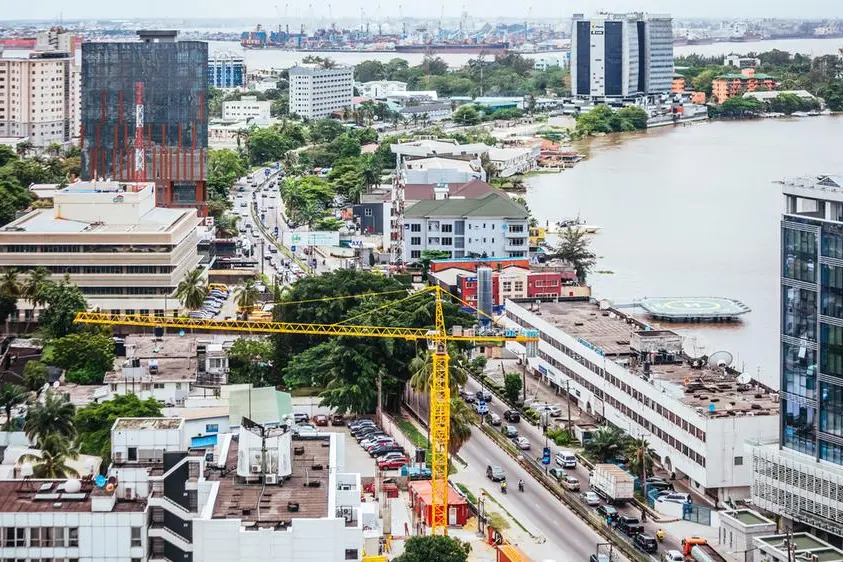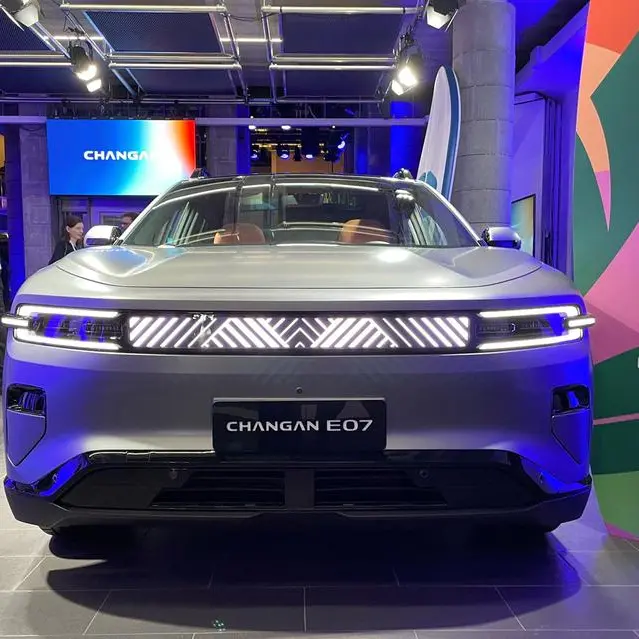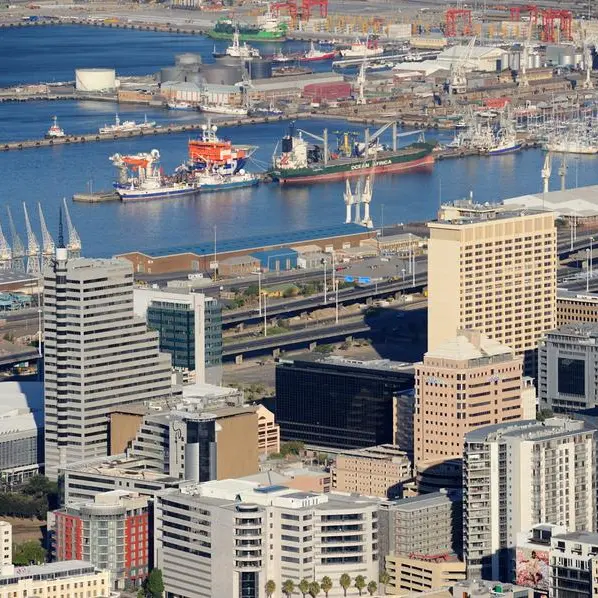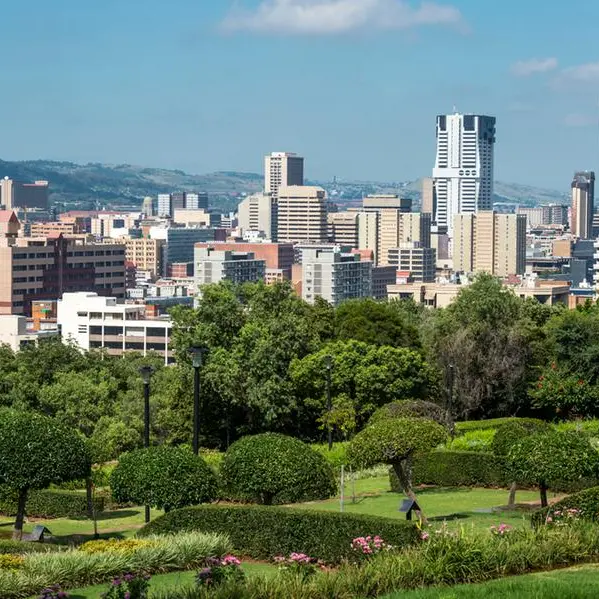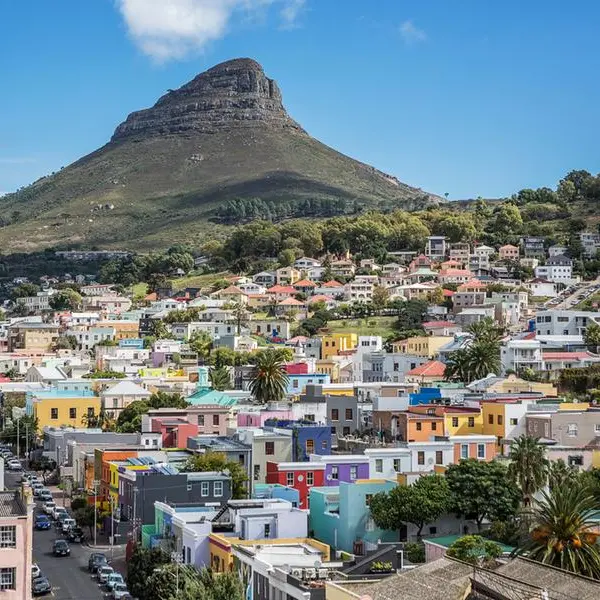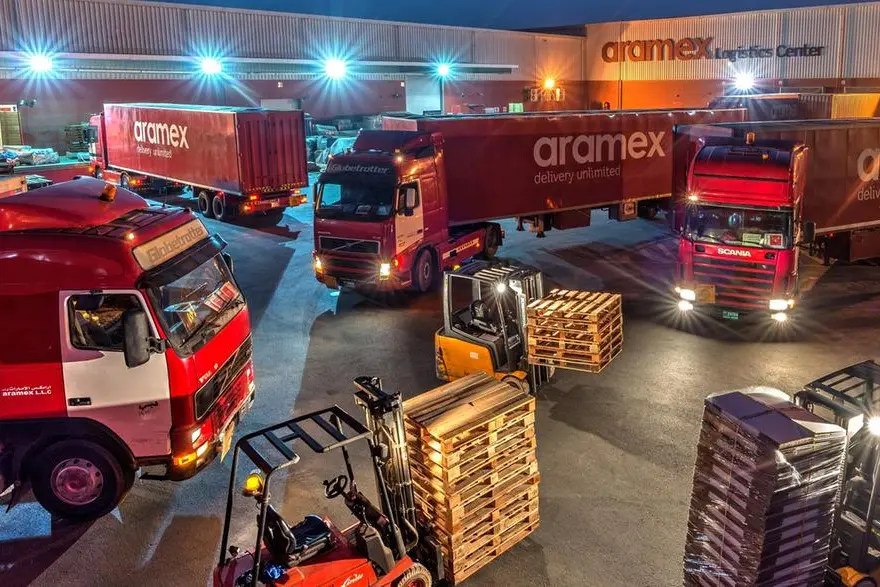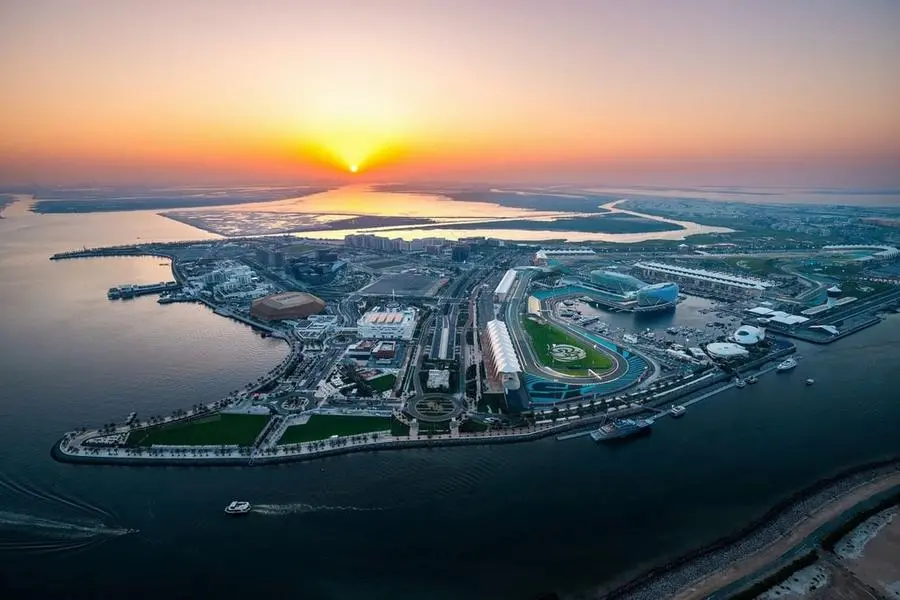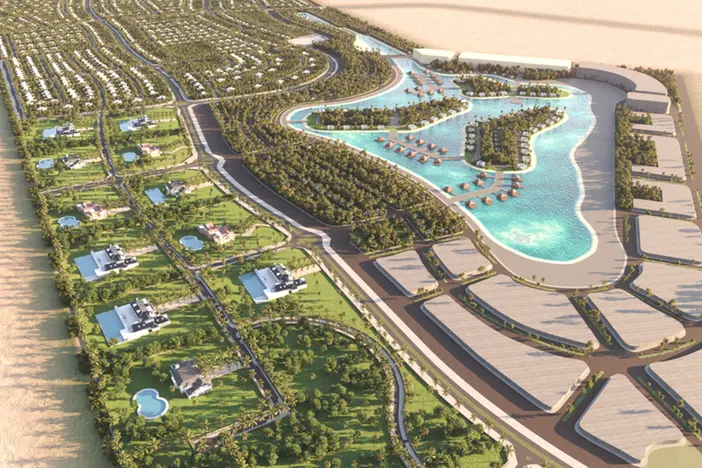PHOTO
Lagos, Nigeria - Aerial view to Victoria Island roads and bridges. Getty Images Image used for illustrative purpose.
Africa stands at a crossroads, where the choices we make today will define the conti- nent’s future for generations. Our people are driving a pow-erful grassroots movement toward greater intra-continental connectivity, demand- ing enhanced trade, jobs, education, and migration across borders.
This demand is a clarion call that must be met with bold, strategic investments and innovative policies. Africa cannot afford incremental change; we need an audacious leap forward that reflects our ambition, fuels our growth, and bridges the connectivity gap that has long shack- led our development. The future of Africa hinges on our ability to link up and in- dustrialise the continent, and the time to act is now.
The popular global narrative about Af- rican migration often focuses on the pain- ful and dangerous exodus to the global North, but this narrative is fundamentally misleading. The reality is that the major- ity of African migration occurs within the continent itself. In 2017, more than half of Africa’s migrants – over 53% – were living in another African country, a figure that rises to over 80% in sub- Saharan Africa.
This data reveals an essential truth: Africans are deeply invested in their continent, seeking opportunities closer to home rather than abroad. This intra- continental movement is about more than just migration – it is about building a future within Africa.
Whether it’s pursuing education, em- ployment, or trade, Africans are finding Samaila Zubairu – CEO of the Africa Finance Corporation ways to connect and collaborate with each other across borders, often in defiance of the barriers that stand in their way. For instance, despite the challenges of aca- demic mobility, 20% of African students who studied abroad in 2021 chose to do so within the continent, highlighting a strong and often overlooked desire for intra-African engagement.
By intentionally nurturing and sup- porting this trend, we can significantly reduce Africa’s brain-drain and retain more of our valuable human capital within the continent.
Furthermore, intra-African remittanc- es, which account for nearly one-fifth of the continent’s total remittance flows, underscore the economic interconnec- tivity within Africa. These remittances, amounting to $20bn out of Africa’s nearly $100bn in total flows, are lifelines that sustain families and businesses, reinforc- ing the economic bonds that are vital for the continent’s growth.
Yet, the drive for connectivity is con- stantly hindered by inadequate infra- structure. The logistical nightmare of travelling across Africa is a stark reminder of the continent’s infrastructural deficiencies. A journey between Kigali and Luanda, which should take only three hours by direct flight, can currently take anywhere from nine to 20 hours due to the lack of direct routes.
This inefficiency not only wastes time but also inflates costs, making intra- African travel 45% more expensive than in Europe. The average cost of sending money within Africa is about 1.3 times the global average.
But here lies a paradox: despite these challenges, the desire for connectivity has fuelled significant growth in intra-Afri- can air travel. In many African countries, more than half of the air passenger traffic is now intra-continental, with African airlines carrying 67m passengers in 2022 alone – a 55.8% increase from the previ- ous year.
Cross-border trade is another area where ordinary Africans are leading the charge. Informal cross-border trade ac- counts for a substantial portion of the continent’s economic activity, represent- ing 7-15% of formal intra-African trade flows and a staggering 30-72% of formal trade between neighbouring countries, according to the United Nations Economic Commission for Africa (UNECA).
The catalyst for continental growth
The demand for intra-continental con- nectivity is clear, and the solution lies in strategic investments in cross-border infrastructure. Africa cannot afford to stumble into the next century with the infrastructure of the last; it needs bold, transformative projects that will reshape the continent’s economic landscape.
Imagine the potential of the Lagos[1]Abidjan expressway (crossing fi vecountries), the Lobito Corridor (crossing three countries), or the Kano-Maradi railway (connecting three Nigerian states with the city of Maradi in Niger), or even a transcontinental route from Mombasa to Dakar – these projects are not just roads and railways; they are the arteries of a connected Africa, ready to facilitate trade, movement, and economic growth.
The Africa Finance Corporation’s State of Africa’s Infrastructure Report 2024 makes a compelling case for such investments.
The report highlights the potential of building economic corridors that connect resource-rich regions with markets, thereby reducing transportation costs and time, boosting trade, and driving economic growth.
The Grand Inga Dam, for instance, which has a capacity to generate 45GW of electricity – more than a third of Africa’s current electricity production – could power the processing of critical minerals, with the Lobito 1 and 2 corridors transporting these resources efficiently across the continent.
Imagine a West Africa where improved road networks and railways allow goods to flow seamlessly across borders, or an East or Southern Africa powered by a regional electricity grid that fuels industrial growth and elevates the quality of life for millions. These are more than just infra structure projects; they are investments in a prosperous African future.
Building on continental initiatives
Fortunately, Africa is not starting from scratch. Several continental and regional initiatives are already laying the ground- work for greater connectivity. The African Continental Free Trade Area (AfCFTA) is a bold step toward the free movement of people, goods, and services across the continent. This ambitious project, if fully realised, could transform Africa into a single market, unlocking unprecedented opportunities for trade and investment.
The Africa Visa Openness Index is an- other positive development, showing sig- nificant progress in reducing the barriers to intra-African travel. In 2023, 50 African countries improved or maintained their scores on the index, with 42 countries offering visa-free entry to citizens from at least five other African countries. Kenya and Rwanda have taken this commitment a step further by offering visa-free access to all Africans, joining The Gambia, Sey- chelles, and Benin in setting a powerful example for the continent.
These initiatives are a testament to what can be achieved when African coun- tries work together. But we cannot af- ford to be complacent. The momentum must be accelerated, and these efforts must be expanded and deepened.
Regional economic communities like ECOWAS, SADC, and COMESA have also made modest but meaningful progress in facilitating connectivity and trade within their regions. These regional efforts, combined with the power of AfCFTA, can pave the way for a truly integrated Africa.
The AfCFTA and the Visa Openness Index are just the beginning. To achieve a truly connected Africa, we need great- er regional cooperation, more ambitious infrastructure projects, and institutions that can drive the continent’s integra- tion forward.
Unlocking Africa’s infrastructure potential
The greatest hurdle to Africa’s infra- structure development is not a lack of vision but a lack of capital. Africa’s fi- nancial institutions are relatively small and underdeveloped, and the continent’s capital reserves inadequate. This financing gap is a major obstacle to the continent’s growth, but it is not insurmountable.
To overcome this hurdle, we need to rethink our approach to financing. The first step is to build and strengthen large, local banks capable of financing major infrastructure projects. However, we must also ensure that all commercial banks across Africa are adequately capitalised, not just the top-tier institutions.
Depending on the size of the econo- my and the addressable market, no bank should have capital of less than $100m equivalent in its local currency. In larger economies, banks should aim for a min- imum capital of $1bn, with a target of reaching $10bn. This capital could then be put to work in financing factories, power plants, roads, and ports across the con- tinent.
By recapitalising Africa’s top-tier banks, we can establish a robust finan- cial backbone to support the continent’s development. We must also capitalise
African Development Finance Institu- tions (DFIs) and Multilateral Development Banks (MDBs) from within Africa. These institutions have a proven track record in supporting infrastructure projects, and with additional capital, they could scale their efforts and attract even more in- vestment.
But perhaps the most innovative so- lution lies in unlocking the potential of Africa’s savings. Despite representing a significant pool of capital, these funds are often underutilised due to regulatory barriers and perceived risks.
By providing de-risking tools – such as government guarantees – and offering regulatory support, we can enable sav- ings pools, like pension funds, to invest in regional infrastructure projects. This approach not only addresses the financing gap but ensures that Africa’s development is fuelled by African capital.
To increase the savings potential of African economies, we must focus on val- ue capture and retention strategies that create quality, higher-paying jobs. This, in turn, would enable governments to better fund schools and provide essential infrastructure.
Pension funds and insurance com- panies are increasingly important in deepening capital markets in developing economies. In countries like South Africa and Nigeria, pension funds have begun to explore this potential.
For instance, Nigeria has increased its pension funds’ allocation to infrastructure financing from $6m to over $110m in less than a decade. National pension fund con- sortia, such as the Kenya Pension Funds Investment Consortium (KEPFIC), can pool resources and expertise to support local infrastructure investment. This model can be replicated across the continent, providing a powerful tool for financing Africa’s infrastructure needs.
Moreover, there is untapped po- tential in the shadow savings locked within Africa’s sizeable informal sector. Africa has the highest level of economic informality in the world, lacking the credible institutions needed to incen- tivise formal savings on a large scale.
Currently, most African savings are non-financial and informal, limiting their ability to support the structural economic transformation the continent urgently needs. To unlock financing for Africa’s infrastructure, we must lever-age both formal and informal financial resources, creating a comprehensive, innovative approach that drives sus- tainable development from within.
Action for Africa’s future
Africa’s future depends on our ability to connect the continent. The demand for intra-continental connectivity is not just a trend; it’s a movement driven by the aspirations of millions of Africans who are already finding ways to trade, learn, and migrate across borders. But to fully realise this potential, we need to invest in the infrastructure that will catalyse in- dustrialisation and connectivity in Africa.
The challenges are significant, but they are not insurmountable. By investing in strategic infrastructure projects, build- ing on existing initiatives, and adopting innovative financing approaches, we can create a continent where borders are not barriers but gateways to opportunity.
The time to act is now. Africa’s future is in our hands, and we have the power to shape it. By coming together, investing in our people, and building the infrastruc- ture that will industrialise and connect our continent, we can create a brighter, more prosperous future for all Africans. The journey will not be easy, but the re- wards will be immense. Let us seize this moment and build a connected Africa that fulfils the dreams of its people. n
© Copyright IC Publications 2022 Provided by SyndiGate Media Inc. (Syndigate.info).
